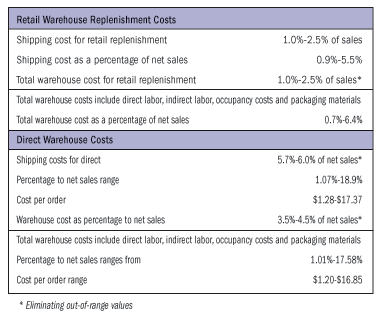Your boss walks into your office, shuts the door, and sits down. He looks worried and a little uneasy. “Our executive management committee just finished meeting with our board. It seems we need to tighten our logistics operations,” he announces, tilting back in his chair. “We know we definitely need to reduce costs, but without sacrificing our service. Your new job is to figure out how—where to direct our focus, which initiatives to dust off the shelves, what must be expanded, where the new efficiencies are. We, or rather you, need to overhaul the entire logistics function of this company.” He holds your gaze for a second, nods twice to be sure you understand, and leaves the door wide open.
Operating across three channels—retail, catalog, and Internet—create complex logistical scenarios. Store consumers want in-stock product, while catalog and Web shoppers want to have their orders shipped same-day and to be able to track their order status in real time. The more efficiently and seamlessly these operations take place, inside the warehouse, with vendors, and at stores, the faster the turnaround times that can be achieved. There are other important benefits as well—increased visibility of incoming shipments, reduced shipping costs, better customer service, and more room for continued growth.
The ongoing challenge for multichannel retailers is to find a way to combine back-end operations and logistics to present a consistent customer experience, whether in-store, online, or at the point of merchandise delivery. Many businesses forge ahead without even developing an operations and transportation plan. But multichannel retailers must partner with logistics vendors to optimize the flow of goods into and out of the warehouse, while reducing overhead expenses and minimizing costs. What’s needed is more communication among marketing, merchandising and management—working in concert with vendors—to fine-tune the process.
The Council of Supply Chain Management Professionals defines logistics management as “that part of supply chain management that plans, implements and controls the efficient, effective forward and reverse flow and storage of goods, services and related information between the point of origin and the point of consumption in order to meet customers’ requirements.” Logistics, an integral part of the supply chain, and logistics networks, systems, and management of these operations have become increasingly more complex. In multichannel businesses, logistics management is now responsible to plan for, implement, and control: – Inbound merchandise from offshore and domestic vendors to the warehouse; – Replenishment of stores by both warehouse operations and vendors; – Cross-docking merchandise to stores or directly to the pack line for direct back orders; – Outbound small package delivery through zone skipping or vendor drop-shipping; – Reverse logistics for single customer returns or to consolidate returns; – Other logistics requirements including warehouse-to-warehouse transfers, store-to-store transfers, and retail store “sends” directly to the customer; and – Multi-warehouse logistics, including warehouse-to-warehouse transfers, vendor receipts, and in sophisticated multi-warehouse operations, reception of vendor shipments at the warehouse closest to the vendor and distribution of the inventory to the warehouses and stores.
Multichannel operations increase competition for sales and customers. Such companies as Cabela’s, Harry and David, and Plow & Hearth are examples of traditional direct marketers who make substantial investments in store retailing. But since the dot-com revolution of the late 1990s, most retailers have also entered the e-commerce environment, pushing their operations into the arena of logistics and fulfillment of small-order, pick, pack, and ship. Many traditional direct marketers’ sales are more than 40% e-commerce in origin. Such operations must continually add functions that reflect the different channels’ requirements.
Most direct marketers and retail companies focus on the customer. They realize that it’s more important for a shopper to experience good customer service than to pinpoint which channel the customer uses to shop. A recent study says that 66% of consumers shop in all three channels—online, catalog, and in-store, yet only 33% of merchants offer a consistent customer experience across all channels. Here is one point at which logistics plays a crucial role.
From a logistics standpoint, the catalog and e-commerce channels of retailing require efficiencies in terms of picking orders the same day or within 24 hours, and they also require efficiencies with regard to cost-effective outbound transportation. Typically, in businesses with more than one warehouse, these operations functions are mirrored for both warehouses. Figure 1, Two-Warehouse Multichannel Logistics Network, illustrates such a multichannel business network.
Retail stores want more frequent deliveries so that products are in stock a higher percentage of the time, in part because of the limited backroom space of most specialty stores. In other words, multichannel companies’ supply chains are dynamic and constantly changing, and to remain competitive, operations management must invest in continual process improvement.
Benchmark studies conducted by F. Curtis Barry & Co. have concluded that shipping costs for retail and direct sales is significant, equaling or exceeding the internal warehouse processing costs for many companies. Figure 2, The Cost of Shipping Compared to Total Warehouse Costs, summarizes this data, the range of data values, and the cost per order. (For comparative purposes, the cost of shipping has been left out of the total warehouse costs because including it has a tendency to distort comparisons between businesses.) “Total warehouse costs” here includes direct labor, indirect labor, occupancy costs, and packaging materials. As the figure demonstrates, logistics impacts efficiencies, operating costs, gross margin, service levels, and sales.
Figure 2: Cost of Shipping Compared to Total Warehouse Costs

In part two, the authors will discuss the four goals necessary for supply chain effectiveness and the best practices to achieve them.
Curt Barry is president of Richmond, VA-based consultancy F. Curtis Barry & Company www.fcbco.com Jose Li is retail industry manager for Memphis-based FedEx Corporate Services http://retail.fedex.com

